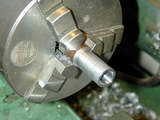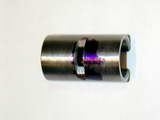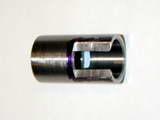Building the Little Dragon Page 1
The numbers on the photos correspond to the text.
Click on a photo to view it larger size.
Click on a photo to view it larger size.
Cylinder
The original designs calls for 9/16" diameter seamless steel tubing with a wall thickness of about 1/16". If you can get it, the 4140 chrome-molybdenum steel used in aircraft construction is ideal. If not, 5/8" 12L14 rod stock is easy to machine.
 Cylinder 1.
Cylinder 1. |
 Cylinder 2.
Cylinder 2. |
 Cylinder 3.
Cylinder 3. |
- A length sufficient for the cylinder, part-off allowance, and a chucking stub si set in the 3 jaw chuck and reduced to 9/16" diameter (not critical--we'll bore the crankcase to suit). It is then center drilled, and drilled through undersize in stages: 1/4", 13/32", and bored to the final size of 7/16" (again, not critical). As the finish size is approached, the boring bar is run through a couple of times at the same setting to allow for spring back. It's amazing how much these "no-cut" passes remove!
Even doing this, there will probably be a light taper in the bore, so the "entry" side will be the bottom the liner. Cut a light 45° chamfer on the inside and outside of end of the liner to aid identification, then part off to final length.
- After parting off to length, the ports are cut. The original was designed to be ported with a hacksaw. This is practical for the cylinder design. Regardless if you mill or saw, you'll need to hold the cylinder in a vice. Make sure you clamp against the ends only; clamping along the length would distort the tube! Here we see the exhaust. On both ports, it's the top edge only whose location in relation to the bottom of the cylinder that is important--although this is moot on the bypass.
- Roy Clough's design was quite unique. By simply removing all the material all the way down to the cylinder liner skirt, the port doubles as the bypass channel. I was worried that this would cause the liner to close up, so I made careful before and after measurements. The answer? Close up it did, by 0.0004" as measured at a point 1/8" up from the bottom edge. While not exactly good, this is acceptable provided we get a close sliding fit in the crankcase of the area around the exhaust port.